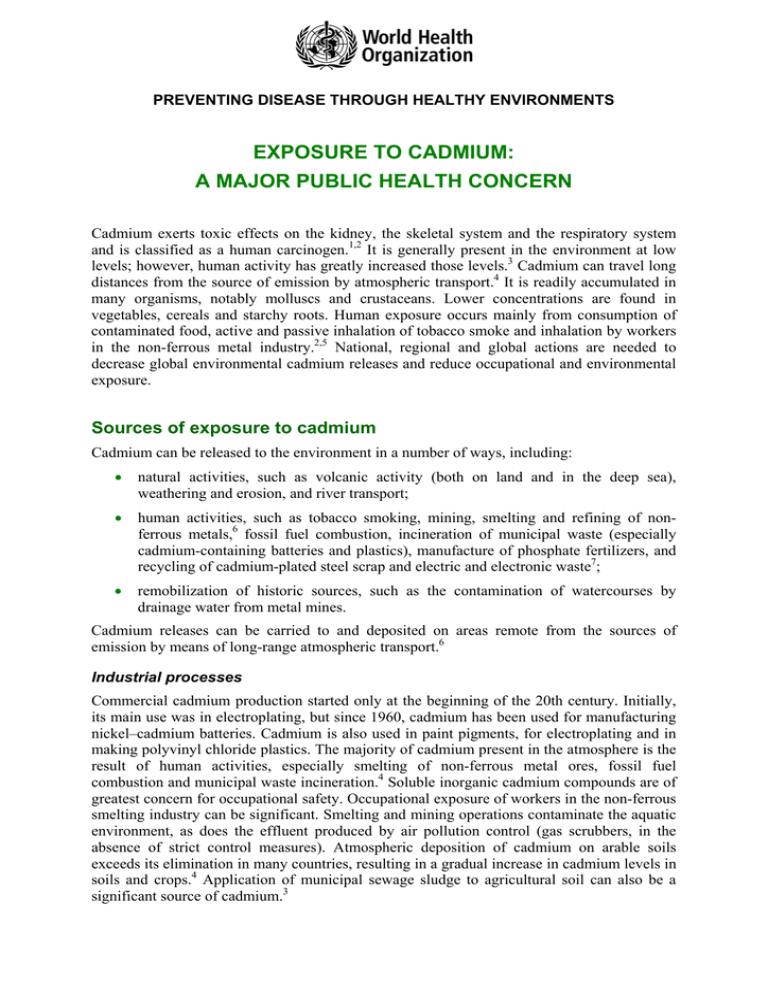
PREVENTING DISEASE THROUGH HEALTHY ENVIRONMENTS
EXPOSURE TO CADMIUM:
A MAJOR PUBLIC HEALTH CONCERN
Cadmium exerts toxic effects on the kidney, the skeletal system and the respiratory system
and is classified as a human carcinogen.1,2 It is generally present in the environment at low
levels; however, human activity has greatly increased those levels.3 Cadmium can travel long
distances from the source of emission by atmospheric transport.4 It is readily accumulated in
many organisms, notably molluscs and crustaceans. Lower concentrations are found in
vegetables, cereals and starchy roots. Human exposure occurs mainly from consumption of
contaminated food, active and passive inhalation of tobacco smoke and inhalation by workers
in the non-ferrous metal industry.2,5 National, regional and global actions are needed to
decrease global environmental cadmium releases and reduce occupational and environmental
exposure.
Sources of exposure to cadmium
Cadmium can be released to the environment in a number of ways, including:
natural activities, such as volcanic activity (both on land and in the deep sea),
weathering and erosion, and river transport;
human activities, such as tobacco smoking, mining, smelting and refining of nonferrous metals,6 fossil fuel combustion, incineration of municipal waste (especially
cadmium-containing batteries and plastics), manufacture of phosphate fertilizers, and
recycling of cadmium-plated steel scrap and electric and electronic waste7;
remobilization of historic sources, such as the contamination of watercourses by
drainage water from metal mines.
Cadmium releases can be carried to and deposited on areas remote from the sources of
emission by means of long-range atmospheric transport.6
Industrial processes
Commercial cadmium production started only at the beginning of the 20th century. Initially,
its main use was in electroplating, but since 1960, cadmium has been used for manufacturing
nickel–cadmium batteries. Cadmium is also used in paint pigments, for electroplating and in
making polyvinyl chloride plastics. The majority of cadmium present in the atmosphere is the
result of human activities, especially smelting of non-ferrous metal ores, fossil fuel
combustion and municipal waste incineration.4 Soluble inorganic cadmium compounds are of
greatest concern for occupational safety. Occupational exposure of workers in the non-ferrous
smelting industry can be significant. Smelting and mining operations contaminate the aquatic
environment, as does the effluent produced by air pollution control (gas scrubbers, in the
absence of strict control measures). Atmospheric deposition of cadmium on arable soils
exceeds its elimination in many countries, resulting in a gradual increase in cadmium levels in
soils and crops.4 Application of municipal sewage sludge to agricultural soil can also be a
significant source of cadmium.3
Food and drinking-water
Cadmium contained in soil and water can be taken up by certain crops and aquatic organisms
and accumulate in the food-chain.4 Food constitutes the main environmental source of
cadmium for non-smokers. Highest cadmium levels are found in the kidney and liver of
mammals fed with cadmium-rich diets and in certain species of oysters, scallops, mussels and
crustaceans. Lower cadmium concentrations are found in vegetables, cereals and starchy roots.
Owing to the larger consumption of such food items, they represent the greater part of daily
cadmium intake in most populations.2,5 Some crops, such as rice, can accumulate high
concentrations of cadmium if grown on cadmium-polluted soil. Acidification of cadmiumcontaining soils may increase the cadmium concentrations in crops.
Cadmium exposure from drinking-water is relatively unimportant compared with exposure
from the diet. However, impurities in the zinc of galvanized pipes and solders in fittings,
water heaters, water coolers and taps can sometimes lead to increased cadmium levels in
drinking-water.
Smoking
The tobacco plant naturally accumulates relatively high concentrations of cadmium in its
leaves. Thus, smoking tobacco is an important source of exposure, and the daily intake may
exceed that from food in the case of heavy smokers. Cigarette smoking can cause significant
increases in the concentrations of cadmium in the kidney, the main target organ for cadmium
toxicity.
World Health Organization (WHO) cadmium guidelines
Provisional tolerable monthly intake (PTMI)
The Joint Food and Agriculture Organization of the United Nations (FAO)/WHO Expert
Committee on Food Additives (JECFA) recently (in 2010) established a provisional tolerable
monthly intake for cadmium of 25 µg/kg body weight.5
Drinking-water
3 µg/l8,9
Air
5 ng/m3 (annual average)6
Health effects2
The kidney is the critical target organ. Cadmium accumulates primarily in the kidneys,
and its biological half-life in humans is 10–35 years.9 This accumulation may lead to
renal tubular dysfunction, which results in increased excretion of low molecular
weight proteins in the urine. This is generally irreversible.
High intake of cadmium can lead to disturbances in calcium metabolism and the
formation of kidney stones. Softening of the bones and osteoporosis may occur in
those exposed through living or working in cadmium-contaminated areas. In an area of
Japan where soil has been contaminated with cadmium from zinc/lead mines, Itai-itai
disease used to be widespread and is still seen in women over 50 years of age. It is
characterized by osteomalacia, osteoporosis, painful bone fractures and kidney
dysfunction.
High inhalation exposure to cadmium oxide fume results in acute pneumonitis with
pulmonary oedema, which may be lethal. Long-term, high-level occupational
exposure is associated with lung changes, primarily characterized by chronic
obstructive airway disease.
There is sufficient evidence that long-term occupational exposure to cadmium (e.g.
through cadmium fume) contributes to the development of lung cancer. There is
limited evidence that cadmium may also cause cancers of the kidney and prostate. The
International Agency for Research on Cancer (IARC) has classified cadmium and
cadmium compounds as carcinogenic to humans (Group 1), meaning that there is
sufficient evidence for their carcinogenicity in humans.10,11
Risk mitigation recommendations
To decrease global environmental cadmium releases and reduce occupational and
environmental exposure to cadmium and associated health effects, the following actions are
needed:
Prohibit smoking in public places.
Reduce as far as is practicable emissions of cadmium—particularly into surface
waters—from mining and smelting, waste incineration, application of sewage sludge
to the land, and use of phosphate fertilizers and cadmium-containing manure. Develop
techniques for the safe disposal of cadmium-containing wastes and effluents.
Promote effective measures to increase recycling of cadmium and to restrict nonrecyclable uses.
Reduce cadmium exposure by, for instance, improving working conditions in the nonferrous smelting industry and disseminating information on the proper use of
fertilizers (which sometimes contain high levels of cadmium).
Raise global awareness on the importance of minimizing waste discharges of cadmium.
References
1. IPCS (2005–2007). Cadmium, cadmium chloride, cadmium oxide, cadmium sulphide,
cadmium acetate, cadmium sulphate. Geneva, World Health Organization, International
Programme on Chemical Safety (International Chemical Safety Cards 0020, 0116, 0117, 0404,
1075 and 1318; http://www.who.int/ipcs/publications/icsc/en/index.html).
2. IPCS (1992). Cadmium. Geneva, World Health Organization, International Programme on
Chemical Safety (Environmental Health Criteria 134;
http://www.inchem.org/documents/ehc/ehc/ehc134.htm).
3. IPCS (1992). Cadmium—Environmental aspects. Geneva, World Health Organization,
International Programme on Chemical Safety (Environmental Health Criteria 135;
http://www.inchem.org/documents/ehc/ehc/ehc135.htm).
4. WHO (2007). Health risks of heavy metals from long-range transboundary air pollution.
Copenhagen, World Health Organization Regional Office for Europe
(http://www.euro.who.int/document/E91044.pdf).
5. WHO (in preparation). Safety evaluation of certain food additives and contaminants in food.
Geneva, World Health Organization (WHO Food Additives Series, No. 64;
http://www.who.int/ipcs/publications/jecfa/monographs/en/index.html) [summary in
FAO/WHO (2010). Summary and conclusions of the seventy-third meeting of the Joint
FAO/WHO Expert Committee on Food Additives, Geneva, 8–17 June 2010. Rome, Food and
Agriculture Organization of the United Nations; Geneva, World Health Organization
(JECFA/73/SC; http://www.who.int/entity/foodsafety/publications/chem/summary73.pdf)].
6. WHO (2000). Cadmium. In: Air quality guidelines for Europe, 2nd ed. Copenhagen, World
Health Organization Regional Office for Europe
(http://www.euro.who.int/__data/assets/pdf_file/0005/74732/E71922.pdf).
7. UNEP (2008). Draft final review of scientific information on cadmium. United Nations
Environment Programme, Chemicals Branch
(http://www.chem.unep.ch/Pb_and_Cd/SR/Draft_final_reviews/Cd_Review/Final_UNEP_Ca
dmium_review_Nov_2008.pdf).
8. WHO (2004). Cadmium in drinking-water. Background document for development of WHO
Guidelines for Drinking-water Quality. Geneva, World Health Organization
(WHO/SDE/WSH/03.04/80;
http://www.who.int/water_sanitation_health/dwq/chemicals/cadmium.pdf).
9. WHO (2008). Cadmium. In: Guidelines for drinking-water quality, 3rd edition incorporating
1st and 2nd addenda. Vol. 1. Recommendations. Geneva, World Health Organization, pp. 317–
319 (http://www.who.int/water_sanitation_health/dwq/GDW12rev1and2.pdf).
10. IARC (1993). Summaries & evaluations: Cadmium and cadmium compounds (Group 1).
Lyon, International Agency for Research on Cancer, p. 119 (IARC Monographs on the
Evaluation of Carcinogenic Risks to Humans, Vol. 58;
http://www.inchem.org/documents/iarc/vol58/mono58-2.html).
11. IARC (in preparation). A review of human carcinogens. C: Metals, arsenic, dusts, and fibres.
Lyon, International Agency for Research on Cancer (IARC Monographs on the Evaluation of
Carcinogenic Risks to Humans, Vol. 100) [summary in Straif K et al. (2009). A review of
human carcinogens—Part C: Metals, arsenic, dusts, and fibres. The Lancet Oncology, 10:453–
454 (http://www.thelancet.com/journals/lanonc/article/PIIS1470-2045(09)70134-2/fulltext).]
© World Health Organization 2010
All rights reserved.
All reasonable precautions have been taken by the World Health Organization to verify the information
contained in this publication. However, the published material is being distributed without warranty of any kind,
either expressed or implied. The responsibility for the interpretation and use of the material lies with the reader.
In no event shall the World Health Organization be liable for damage arising from its use.
WHO gratefully acknowledges the financial support provided by the Swiss Federal Office for the Environment.
Printed by the WHO Document Production Services, Geneva, Switzerland
Public Health and Environment
World Health Organization
20 Avenue Appia, 1211 Geneva 27, Switzerland







